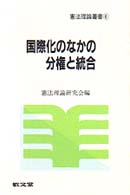- ホーム
- > 洋書
- > 英文書
- > Politics / International Relations
Full Description
The term "middle power" is conceptually fragile. Some scholars have even argued for abandoning it. This book argues that the concept needs to be analysed more profoundly and that new analytical tools need to be developed to better understand the phenomenon. The traditional approach, based on Western states, is insufficient and has become increasingly irrelevant in a transformed global environment. Instead of drawing from a single theory of international relations, the contributors have chosen to build upon a wide range of theories in a deliberate demonstration of analytic eclecticism. A pluralistic approach provides stronger explanations while remaining analytically and intellectually rigorous. Many of the theory contributions are reconsidering how the largely "Western" bases of such theorising need revising in light of the "emerging middle powers", many of which are in Asia.
Presenting a strong argument for studying middle powers, this book explores both the theory and empirical applications of the concept by rethinking the definition and characteristics of middle powers using a range of case studies. It examines changes in the study of middle powers over the last decade, proposing to look at the concept of middle powers in a coherent and inclusive manner. Finally, it aims to further the discussion on the evolution of the international system and provides sound conclusions about the theoretical usefulness and empirical evolution of middle powers today.
Contents
List of figures and tables
Notes on contributors
Introduction
DAVID WALTON AND THOMAS S. WILKINS
PART I
Theoretical approaches
1 Middle powers: A comprehensive definition and typology
TANGUY STRUYE DE SWIELANDE
2 The historical determination of the middle power concept
GABRIELE ABBONDANZA
3 Defining middle powers through IR theory: Three images
THOMAS S. WILKINS
4 Interlocutors for peace? Bringing middle powers in from the theoretical cold
ALLAN PATIENCE AND CHIRAAG ROY
5 Middle powers in the agency-structure debate
FEDERICA DE PANTZ
6 Too big to fit? Locating "rising powers" regarding the middle power category
JOAN DEAS
7 Interrogating middle powers' behaviour
CATHERINE JONES
8 Faith no more: Reflections on the distinction between traditional and emerging middle powers
EDUARD JORDAAN
9 Middle power assertiveness as a behavioural model in foreign policy
ANDRIY TYUSHKA
PART II
Case studies
10 Middle powers and power shifts: Australian foreign policy towards China and Japan
DAVID WALTON
11 Adjusting the middle to fit the frame: Canada in the changing global order
JEREMY PALTIEL AND KIM RICHARD NOSSAL
12 India: Breaking out of the middle power straitjacket?
EMILIAN KAVALSKI
13 The case of Pakistan: Middlepowermanship as a role
DOROTHÉE VANDAMME
14 The Singapore paradox: The "little red dot" as a "middle power"
LAM PENG ER
15 Meddling middle powers: Can diplomacy crack the North Korean conundrum?
VIRGINIE GRZELCZYK
16 Middle power hybridisation and China
JONATHAN H. PING
Conclusion
TANGUY STRUYE DE SWIELANDE AND DOROTHÉE VANDAMME
Afterword
ANDREW F. COOPER
Index






